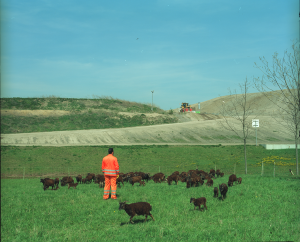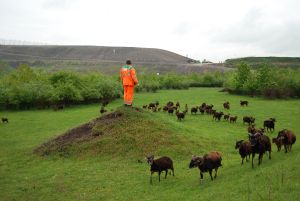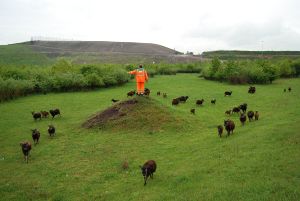Idea of Infinity
While thinking about the topic Space is the place and considering the universe and space on its own, the first thing, which came into mind was the idea of infinity. The feeling you get when you look at the stars and start thinking about what is behind the universe, its size and expansion. It is a strange feeling – because your mind cannot deal with its unaccountable character.
With a light installation I wanted to provoke the feeling of infinity from the viewer.
During my research I figured out, that a lot of light-artists have tried to do that in the past: James Turrell and Olafur Eliasson just to name the two most popular ones.
<videoflash type="youtube">s6RMAkqaOT4|320|240</videoflash> <videoflash type="youtube">enT2GNItJME|320|240</videoflash>
Research on Infinity
I continued my research and came across symbols, theories and art-projects, which were also dealing with the idea of infinity and led me towards my final project Der Müllmann.
Already during the Romantic period, artists were trying to visualize the feeling of infinity: Superiority. For example in the paintings of Caspar David Friedrich one can see persons, who are watching the giant and wide nature. Today, you have photographers like Andreas Gursky, who make links to the German Romantic and deal – among other things - with the infinity of the human mind.
When I did research about universe and its expansion, the first name I pounced on was Einstein and a lot of theories about the Big Bang. Looking deeper into the mathematics, I found the symbol of infinity . It looks like a rotated number 8, but you can also see it as a moebius strip. The German mathematician August Ferdinand Möbius discovered it in 1858. You can follow every part of the moebius strip, without crossing and edge. Infinite. The painter and artist M.C. Escher visualized the moebius strip and visualized the idea of infinity in many of his paintings, too.
Also the idea of an endless process can be found in the Turing Machine.
Waste and Infinity
Looking for the moebius strip in our daily life, it’s visualized as the recycling symbol. It’s a sign for circulation and represents its endlessness.
The first idea was to follow the way of a plastic bottle. How a bottle and its parts spread all over the world and how “the bottle” is finally making it outer space – as a food box for the astronauts. Involving all the recycling processes in between (which would have make a link to the Turing Machine).
Coming back to the astronauts, waste circulation and the outer space - I have made links between astronauts and garbage men and between their missions. This was leading me to another project called Helden which was exhibited during the summary 2010 at Bauhaus University. The idea of Helden was developed in the course Mnemosyne by the professorship of Moden und öffentliche Erscheinungsbilder.
In order to visualize the concept of infinity and combine the idea of Romantic, garbage and circulation, I wanted to take a picture of a garbage man in front of a disposal side watching the immenseness of waste. As a result I was calling the local disposal site, asking for possibilities for a photo shooting. Surprisingly I came to know, that since 2005 disposal sites - as we used to know them from the media - are not existing any longer in Germany. New laws and orders achieved, that many disposal sites in Germany got closed down or have slowly renaturalized within a sustainable process. The capital of Thuringia, Erfurt, still has a disposal site, where some of the regional garbage can be found, after an environmentally compatible pre-treatment.
Erfurt-Schwerborn and the Romantic
I was researching about the disposal site Erfurt-Schwerborn on the internet and found a media report on 3sat, where I could get a first impression of the scenery: The environment with its sheep and its landscape.
The idea of a garbage man in front of a trash mountain was pushed away by the idea of the garbage man watching the changing nature of Erfurt-Schwerborn surrounded by sheep. Bizarre, absurd and staged would it open the topic of disposal sites and its change in Germany and bring a link back to the German Romantic.
As a next step, I was calling the disposal site Erfurt-Schwerborn and asked for a photo appointment, and got invited to the Deponie-Wanderung: A regular happening, where the population of Erfurt can become observers of a changing landscape and its use.
With the references of Caspar David Friedrichs paintings I went to Erfurt-Schwerborn and took a picture of a staged and also faked garbage man surrounded by sheep. After getting in contact with a real garbage man and talking to a go-to person I made a new appointment, in order to watch the area and find the right spot for my picture.
For more informations about Erfurt-Schwerborn - Click here
.
The final picture Der Müllmann
A higher point on a green spot, where the sheep is grazing was the ideal point for staging the garbage man. Looking for more obvious characteristics of Caspar David Friedrichs’ work I took the Der Wanderer über dem Nebelmeer as a reference for the final picture.
Finally I made an appointment with the garbage man, who is responsible for the sheep. We met in the early morning hours in order to get a foggy atmosphere. Surrounded by the soay sheep, he is holding a stick. In the background of the Müllmann-scene you can see the old mountain of the disposal site, the garbage man is watching.
Using the size relationship of Friedrichs Der Wanderer über dem Nebelmeer for Der Müllmann made a non-obvious link for me to this painting.
Exhibited: Energie. Experiment. Erlebnis. Ein Tag im Land der Ideen. (2010)




